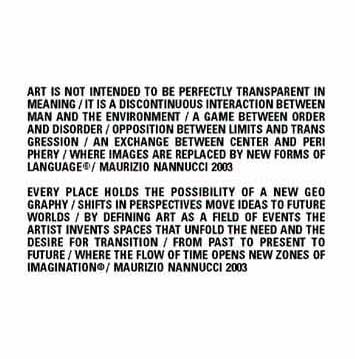![]()
2 |
|
maurizio nannucci

 Art
is not intended to be..., 2003
Art
is not intended to be..., 2003
print on paper
20 x 27 cm
Art is not
intended to be..., 2003
stampa su carta
cm 20 x 27
![]()
 Exhibitions
(selection)
Exhibitions
(selection)
1993 Kasseler Kunstverein, Friedericianum, Kassel
1994 Bibliothèque Nazionale de France, Paris
1995 Wiener Secession, Wien
1998 Museum Rupertinum, Salzburg
1998 the Museum of Contemporary Arts, Sidney
2000 Venice Architecture Biennial
2000 Art/Light, at the Galerie Beyeler, Basel
2000 Dopo Paesaggio at Palazzo Pitti, Florence
2001 California College of Art and Crafts, San Francisco
2003 Il Belvedere dell’Arte, Orizzonti, Forte Belvedere, Florence
2003
Magazines by Artists, Art Metropoli, Toronto
![]()
The
artist is well-known in international artistic circles for his conceptual
works, such as his neon structures, and has also collaborated with various
architects (Renzo Piano, for example, for the Auditorium in Rome and Time
Building in New York).
During the 1970s Nannucci participated in the artistic movements typical of the day, experimenting and elaborating his study of verbal structures in relation to the use of new media (audio, video, radio, photography, hologrammes). From his experimentation he developed a concept of a new art that brought him close to developments in international art. He worked with the group of musical phonology “S 2f M” which elaborated visual processes together with studies of electronic music. The concept behind his first works, Dattilogrammi, was based on graduated relationships of rhythmic versions of verbal expressions, making use of a typewriter.
Essentially his works concentrate on the concept of communication, through radio, film, video, artists’ books, journals, leading up to the events organised by the exhibition space Base-Progetti per l’Arte.Art is not intended to be..., presented at Uscita Pistoia, is, as in all his works, the importance of the piece and the concepts are defined by the artist’s intervention; places and things no longer represent standardised examples of meaning, but are redefined, almost renamed with a new term, in a new statement that, by redefining the object, offers the possibility of a new logical sense.
Art is defined through thought and not through the fabric of the work; by investigating and reflecting on the language of aesthetics, our intellect’s perception is queried by continually studying the nature of art through an analysis of its linguistic expressions. In 1978 at the Venice Biennial, for example, he presented Image du ciel, a long streamer bearing the title of the work, that flew across the skies of Venice tied to a plane.
In many other works the artist uses neon, as if to emphasise the concept, the sense of illumination - new light representing new knowledge. The neons are used to create images, geometric forms, they present writing, words that reflect the role of art and the artist. In Grandi Rilievi the use of neon links up empty rooms connected to each other by coloured images, a strategem that re-shapes and redefines the physical and mental concepts.
Nannucci’s works, his conceptual experimentation, comment on the general meaning of conscience, they subtly invade places and things annulling their identity and revealing what has been hidden by superficiality. A new, redefined meaning emerges, the end result of a conceptual process that liberates situations from the rhetoric of a stereotyped consciousness.
Maurizio Nannucci was born in Florence, 1939. He lives and works in Florence.



L’artista si impone nel panorama artistico internazionale per i suoi studi nell'ambito dell'arte concettuale, come i suoi interventi al neon, collaborando anche con architetti (ad esempio Renzo Piano per l’Auditorium di Roma e per il Time Building di New York.
Intorno agli anni Settanta l’artista è partecipe dell'attitudine, tipica di quegli anni, alla sperimentazione, elaborando la sua ricerca sulle strutture verbali connesse all’uso di nuovi media (audio, video, radio, foto, ologrammi). Le sue sperimentazioni approdano ad un concetto di arte rinnovata che lo pongono in relazione con gli esiti dell’arte internazionale. Ha partecipato al gruppo di fonologia musicale “S 2f M”, dove processi visivi venivano elaborati in sintonia con gli studi sulla musica elettronica; i suoi primi lavori, dattilogrammi, basavano la ricerca espressiva sui rapporti scalari di stesure ritmiche di espressioni verbali, con l’utilizzo di una macchina da scrivere. I suoi interessi vertono essenzialmente sul concetto di comunicazione, dalla radio, film, video, libri d’artista, riviste, fino ad arrivare alle attività promosse dallo spazio Base-Progetti per l'Arte.
Le sue opere, come Art is not intended to be..., presentato ad Uscita Pistoia precisano l’entità degli oggetti e dei concetti attraverso l’intervento dell’artista, i luoghi e le cose non rappresentano più prototipi standardizzati di senso ma vengono ridefiniti, quasi ribattezzati ad un nuovo fonema, ad un nuovo enunciato che nel ridefinire l’oggetto offre a noi la possibilità di un senso logico nuovo.
L’arte si definisce attraverso il pensiero e non attraverso la materialità dell’opera, un operazione che indaga, riflette sul linguaggio estetico, interroga la percezione del nostro intelletto in una continua riflessione sulla natura dell’arte attraverso l’analisi dei suoi elementi linguistici. Nel 1978 alla Biennale di Venezia, ad esempio, presenta il lavoro Image du ciel, una lunga striscia, recante il titolo dell’opera, che trainata da un aereo attraversava il cielo di Venezia.
In molti altri lavori l’artista adopera il neon, quasi a sottolineare il concetto, il senso dell’illuminazione, di nuova luce intesa come nuovo sapere. I neon vengono utilizzati per creare immagini, forme geometriche, veicolano scrittura, parole che riflettono sul ruolo dell’arte e dell’artista. Nei Grandi Rilievi l’uso del neon fa da tramite a stanze vuote collegate tra loro attraverso immagini colorate, operazione che rimodella e ridefinisce lo spazio fisico e mentale.
Le sue ricerche, sperimentazioni concettuali, dialogano sul senso comune della conoscenza, investono delicatamente luoghi e le cose annullandone semanticamente la loro identità, rendono visibile ciò che l’ovvietà nasconde. Il significato riemerge, nuovo, ridefinito, risultato ultimo di un percorso concettuale che libera i luoghi dalla retorica di una conoscenza stereotipata.
Maurizio Nannucci nasce a Firenze nel 1939, dove attualmente vive e lavora.
